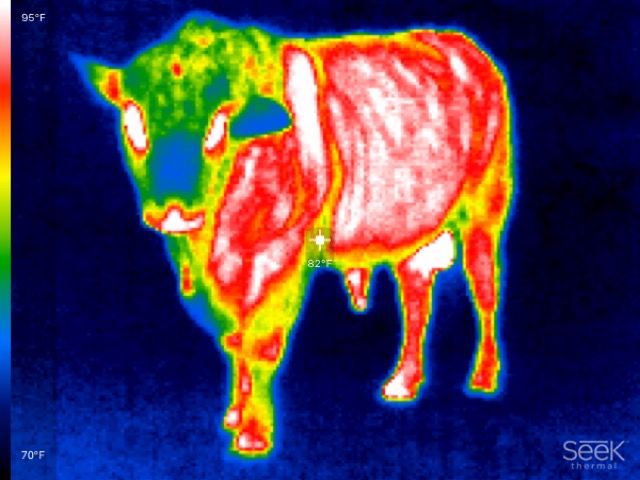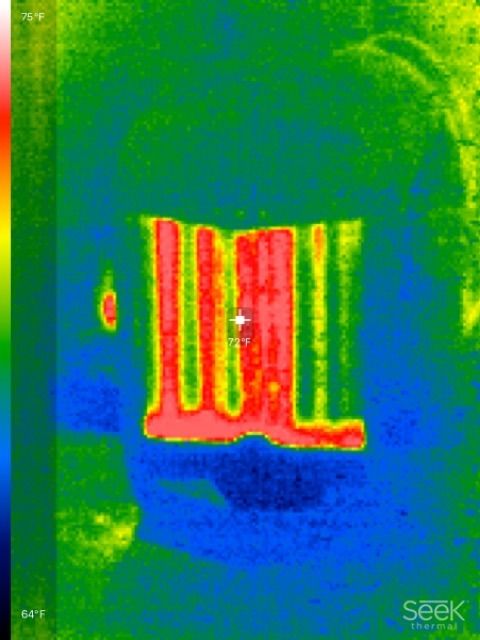
 |
|
|||||||
| Forum Rules | Firearms Safety | Firearms Photos | Links | Library | Lost Password | Email Changes |
| Register | FAQ | Calendar | Search | Today's Posts | Mark Forums Read |
 |
|
|
Thread Tools | Search this Thread |
|
|
#1 |
|
Junior member
Join Date: February 27, 2015
Posts: 1,768
|
Annealing Temp Indicatication
The Travers Tool Co. was showing hand head FLIR units on sale...
So I was hoping it would be reasonable so I could get my own latest generation FLIR. http://www.travers.com/thermal-ir-im.../p/96-200-330/ Turns out $349.99 gets you the -13*F to +716*F models. The gas annealing guys can use it, +700*F maintained for several seconds will properly & throughly anneal shoulders/necks. Electrical annealing, particularly quick electrical annealing it's not a high enough temp range, needing at least +750*F on the scale. Last edited by JeepHammer; January 30, 2017 at 07:55 PM. |
|
|
|
|
#2 |
|
Senior Member
Join Date: November 22, 2006
Posts: 3,077
|
Have you used one?
I played with one for awhile, you can find the warmest spots on a bull.  Or see what cores are clogged on the older 8N radiator.  But the refresh rate was less than ideal for something heating up that rapidly. If your flame heating (propane) with a machine it's easy to adjust the speed so it stops heating right before the flame changes from blue to orange. Nothing extra to buy and perfect results. |
|
|
|
|
#3 |
|
Senior Member
Join Date: July 18, 2008
Posts: 7,249
|
http://www.glowshiftdirect.com/diese...er-gauges.aspx
If I wanted to know the temperature I would consider a gage from the above link. For me it is not a problem but I have a pyrometer with 8 selections/positions. When it comes to trouble shooting there is nothing like turning a knob when determining where the heat is and or is not and it is hand free. F. Guffey Last edited by F. Guffey; January 31, 2017 at 01:10 PM. Reason: add b and removing a w |
|
|
|
|
#4 |
|
Senior Member
Join Date: January 3, 2017
Posts: 1,583
|
I used tempilaq on the inside of the necks to determine the heat. With my setup it takes just under 6 seconds to properly anneal a cartridge. I move the flame to a preset distance for each cartridge.
Tempilaq is the best thing to check the temperature you get and measuring on the inside of the neck ensures that you are getting the heat into the brass and not measuring the flame temperature. |
|
|
|
|
#5 |
|
Senior Member
Join Date: July 18, 2008
Posts: 7,249
|
As we all know the black smith under the spreading chestnut stands but when he going for color he is in the back part of the building going for color. And I wonder how many times did he have to try before he figured it out.
F. Guffey |
|
|
|
|
#6 |
|
Senior Member
Join Date: April 10, 2012
Location: San Diego CA
Posts: 6,875
|
Jeep , How would one go about using that ? I see how it works and or what you see but how do you know your at 750* and not 675* ? Does it have some sort of pin point laser that you point at a specific spot and it tells you what that area is heated to or is it just that general picture and you need to determine the temp ?
__________________
If Jesus had a gun , he'd probably still be alive ! I almost always write my posts regardless of content in a jovial manor and intent . If that's not how you took it , please try again .  
|
|
|
|
|
#7 |
|
Junior member
Join Date: February 27, 2015
Posts: 1,768
|
The one I borrow from work is bigger, and about $15,000
The hand held unit they use in the field has two lasers, the most accurate reading is between the lasers, the display shows the highest temp detected. Admittedly, I didn't think about the refresh rate, the expensive unit is real time, I haven't played with the hand held enough to tell if it's real time or a series of time spaced images. I found out that Templiq is a little off, depending on how much thinner used, humidity, the time from apply to heating, the age of the bottle, etc. So I also used a thermocouple when gas heating. The metal thermocouple runs into trouble when induction heating, the Stainless probe heats faster than the brass, That's why I used infrared as my verifying check of the Templiq. My 'Last Word' has always been the end result, the Rockwell test. The process to get that last result takes different routes, gas or induction, high temps and faster times or lower temps and longer times, etc. I *Wish* they would sell a 800*F unit for the same price! As for application, if you are doing gas, 750*F & 800*F in the neck if you are 'Fast' cooking. Marking the outside of the case exposes the Templiq to direct flame heat, so you CAN use Templiq to see how far down the heat reaches, But you can NOT use it on the outside of neck/shoulder to tell when the brass reaches target temp because of direct flame exposure. I do the 800*F stripe to tell if the case overheated. This is what tipped me to mouth overheating. Let me know I needed to heat the case (side) a little lower down to keep the mouth from overheating before the shoulder reached target temp. That same test let me know the mouth needs to protrude slightly op/out of the annealing coil. Since induction heats the brass from within, and the mouth is the thinnest part of the case there is less brass to react with the induction, so it doesn't fry brass like gas will, But I was still finding some signs of overheating when the power got cranked up. The 'Easiest' solution was to lower the coil a little on the case and the overheating signs immedately went away. When induction annealing things get a little more simple with Templiq because you can apply to the outside of the case neck/shoulder. I find with my fat fingers and less than X-ray vision painting the inside of a .22 case neck is a pain in the butt!  I'm still waiting for evolution to give me that magnified vision & third arm with super steady hand... Until then I make due with magnifier and tiny art store paint brushes. |
|
|
|
|
#8 |
|
Senior Member
Join Date: January 3, 2017
Posts: 1,583
|
The speed of heating the thin brass of a cartridge is not a bad thing. You have to get the brass to 750F in order to anneal it properly. As long as the brass is heated completly through to that temperature it is fine. I use the 750 Temilaq on the inside of the neck to set up my annealer. From that I can use that flame position to do all the brass of that size. I have the position marked so I am close enough to make at the most a final adjustment on the flame. When annealing 8 different cartridges you learn to keep the work and setup down to a minimum.
|
|
|
|
|
#9 | |
|
Senior Member
Join Date: November 22, 2006
Posts: 3,077
|
Quote:
|
|
|
|
|
|
#10 |
|
Junior member
Join Date: February 27, 2015
Posts: 1,768
|
The larger unit at work is real time.
You can shoot people and see the move over the unit, and it's real time. Don't know about the hand held units... Yet... As for time/temp, You will find that FLAME annealing will give best results around 725-730*F since flame annealing takes more TIME to saturate case from outside to inside. Reaching 750*F with flame you are getting dangerously close to going mono-crystalline' loosing grain structure. The idea of annealing is to restore grain structure, from compacted/'Hard' to properly spaced/non-compacted. Overheating the brass, or cooking for too long you will wind up with 'Soft', but destroying the grain structure that allows the brass to expand/contract while forming. With very fast annealing (induction), the brass heats very evenly, on a molecular scale, so slightly higher temps are required to normalize/space out the grain structure. Under no circumstances have I found a case that survived 800*F intact. The brass got 'Soft', but went monocrystalline and was ruined. That's the reason 'Proper' annealing is so difficult, The home reloader can't Rockwell test for hardness, and the home reloader can't chemical/magnified visual test for grain structure. *IF* we as a group could get an electrical annealer 'Standardized' (open source so one person/company can't make it proprietary), Those of us that CAN do Rockwell/gain testing/inspection can give time/temp goals for each caliber/brand of brass. I'm on my fourth bin (about a million) LC 12 to LC 16 brass (since ATK took over Federal & Lake City) and I'm finding it remarkably CONSISTANT. WCC brass is still all over the place depending on year of manufacture, but we already knew that from trial & error experience. Winchester civilian brass is as consistant as it's always been. The tough part is getting us all on the same consistancy scale, That's never going to happen with gas since no two torch tips are the same, no two guys are going to have the same gas pressure, And no two guys are going to have the torch the same space from the case... With gas, there is the question of rotation of the case and that speed variable... Since a coil induction annealer doesn't need to rotate the case, that's one huge variable removed, *IF* we settle on a particular induction unit, power supply, the output should be consistant, removing another variable. This *Should*, in theroy at least, give us pretty common/consistant footing for developing time/temp for correct annealing. |
|
|
|
|
#11 | |
|
Senior Member
Join Date: November 22, 2006
Posts: 3,077
|
Quote:
|
|
|
|
|
|
#12 |
|
Senior Member
Join Date: July 18, 2008
Posts: 7,249
|
And again I ask about where the village black smiths stands; if he is looking for color he is not beneath the spreading Chestnut tree.
F. Guffey |
|
|
|
|
#13 | |
|
Senior Member
Join Date: November 22, 2006
Posts: 3,077
|
Quote:
So no one is beneath the tree and no one from that time is still standing. |
|
|
|
 |
| Thread Tools | Search this Thread |
|
|